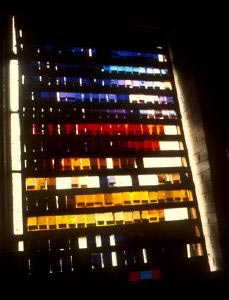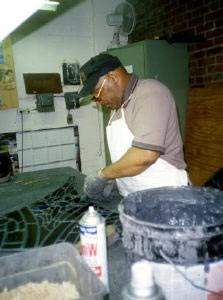More
Information About Melchizedek
Certainly
they were ignorant of any coming danger, when Abram, having divided
his force, fell upon them, in the dead of night, from several
sides at the same time, inflicted a great slaughter, and pursued
them to close by Damascus. All the spoil and all the captives,
among them Lot also, were rescued and brought back. As the returning
host of Abram entered the valley of Shaveh, close under the walls
of what afterwards became Jerusalem, they were met by two persons
bearing very different characters, and coming from opposite directions.
From the banks of Jordan the new king of Sodom, whose predecessor
had fallen in battle against Chedorlaomer, came up to thank Abram,
and to offer him the spoils he had won; while from the heights
of Salem - the ancient Jerusalem - the priest-king Melchizedek
descended to bless Abram, and to refresh him with "bread
and wine." This memorable meeting seems to have given the
valley its name, "the king's dale;" and here, in later
times, Absalom erected for himself a monumental pillar.(2 Samuel
18:18) But now a far different scene ensued, and one so significant
in its typical meaning as to have left its impress alike on the
prophecies of the Old and in the fulfillment of the New Testament.
Melchizedek appears like a meteor in the sky - suddenly, unexpectedly,
mysteriously, - and then as suddenly disappears. Amid the abundance
of genealogical details of that period we know absolutely nothing
of his descent; in the roll of kings and their achievements,
his name and reign, his birth and death remain unmentioned. Considering
the position which he occupies towards Abram, that silence must
have been intentional, and its intention typical; that is, designed
to point forward to corresponding realities in Christ. Still
more clearly than its silence does the information which Scripture
furnishes about Melchizedek show the deep significance of his
personality. His name is "King of Righteousness," his
government that of the "Prince of Peace;" he is a priest,"
neither in the sense in which Abram was, nor yet "after
the order of Aaron," his priesthood being distinct and unique;
he blesses Abram, and his blessing sounds like a ratification
of the bestowal of the land upon the patriarch; while Abram gives
"him tithes of all." There is in this latter tribute
an acknowledgment of Melchizedek both as king and priest - as
priest in giving him "tithes," and as king in giving
him these tithes of all the spoil, as if he had royal claim upon
it; while Abram himself refuses to touch any of it, and his allies
are only allowed to "take their portion."
This
is not the place to discuss the typical meaning of this story;
yet the event and the person are too important to pass them unnoticed.
Twice again we meet Melchizedek in Scripture: once in the prophecy
of Psalm 110:4: "Thou art a priest for ever after the order
of Melchizedek;" the other time in the application of it
all to our blessed Savior, in Hebrews 7:3. That Melchizedek was
not Christ Himself is evident from the statement that he was
"made like unto the Son of God" (or "likened unto"
Him, Hebrews 7:3); while it equally appears from these words,
and from the whole tenor of Scripture, that he was a type of
Christ. In fact, we stand here at the threshold of two dispensations.
The covenant with Noah had, so to speak, run its course, or rather
was merging into that with Abram. As at the commencement of the
New Testament, John gave testimony to Jesus, and yet Jesus was
baptized by John; so here Melchizedek gave testimony to Abram,
and yet received tithes from Abram. If we add, that in our view
Melchizedek was probably the last representative of the race
of Shem in the land of Canaan, which was now in the hands of
the Canaanites, who were children of Ham, as well as that he
was the last representative of the faith of Shem, in the midst
of idolatry - being a "priest of the most high God,"
- the relation between them will become more clear. It was the
old transferred to the new, and enlarged in it; it was the rule
and the promise of Shem, solemnly handed over to Abram by the
last representative of Shem in the land, who thus gave up his
authority in the name of "the most high God, possessor of
heaven and earth," "which hath delivered" Abram's
enemies into his hands. It has been well observed, that "Abram's
greatness consisted in his hopes, that of Melchizedek in his
present possession." Melchizedek was both a priest and a
king, - Abram only a prophet; Melchizedek was recognized as the
rightful possessor of the country, which as yet was only promised
to Abram. True, the future will be infinitely greater than the
present, - but then it was as yet future. Melchizedek owned its
reality by blessing Abram, and transferring his title, as it
were, to him; while Abram recognized the present, by giving tithes
to Melchizedek, and bending to receive his blessing. Thus Melchizedek,
the last representative of the Shemitic order, is the type of
Christ, as the last representative of the Abrahamic order. What
lay in germ in Melchizedek was to be gradually unfolded - the
priesthood in Aaron, the royalty in David - till both were most
gloriously united in Christ. Melchizedek was, however,
only a shadow and a type; Christ is the reality and the antitype.
It is for this reason that Scripture has shut to us the sources
of historical investigation about his descent and duration of
life, that by its silence it might point to the heavenly descent
of Jesus. For the same reason also Abram, who so soon afterwards
vindicated his dignity and position in the language of superiority
with which he declined the king of Sodom's offer of the spoils,
bent lowly before Melchizedek, that in his blessing he might
receive the spiritual inheritance which he now bequeathed him.
Nor will the attentive reader fail to remark the language in
which Melchizedek spake of God as "the most high,"
and the "possessor of heaven and earth" - terms which
Abram adopted, but to which he added the new name of "Jehovah,"
as that of "the most high God, the possessor of heaven and
earth" - a name which indicated that covenant of grace of
which Abram was to be the representative and the medium. It is
quite in accordance with this whole transaction that Abram put
aside the offer of the king of Sodom: "Give me the persons,
and take the goods to thyself." Assuredly, it had not been
as an ally of the king of Sodom, but to vindicate his position,
and that of all connected with him, that the Lord had summoned
Abram to the war, and given him the victory. And so these figures
part, never to meet again: the king of Sodom to hasten to the
judgment, already lingering around him; the king of Salem to
wait for the better possession promised, which indeed was already
commencing.
![]()











